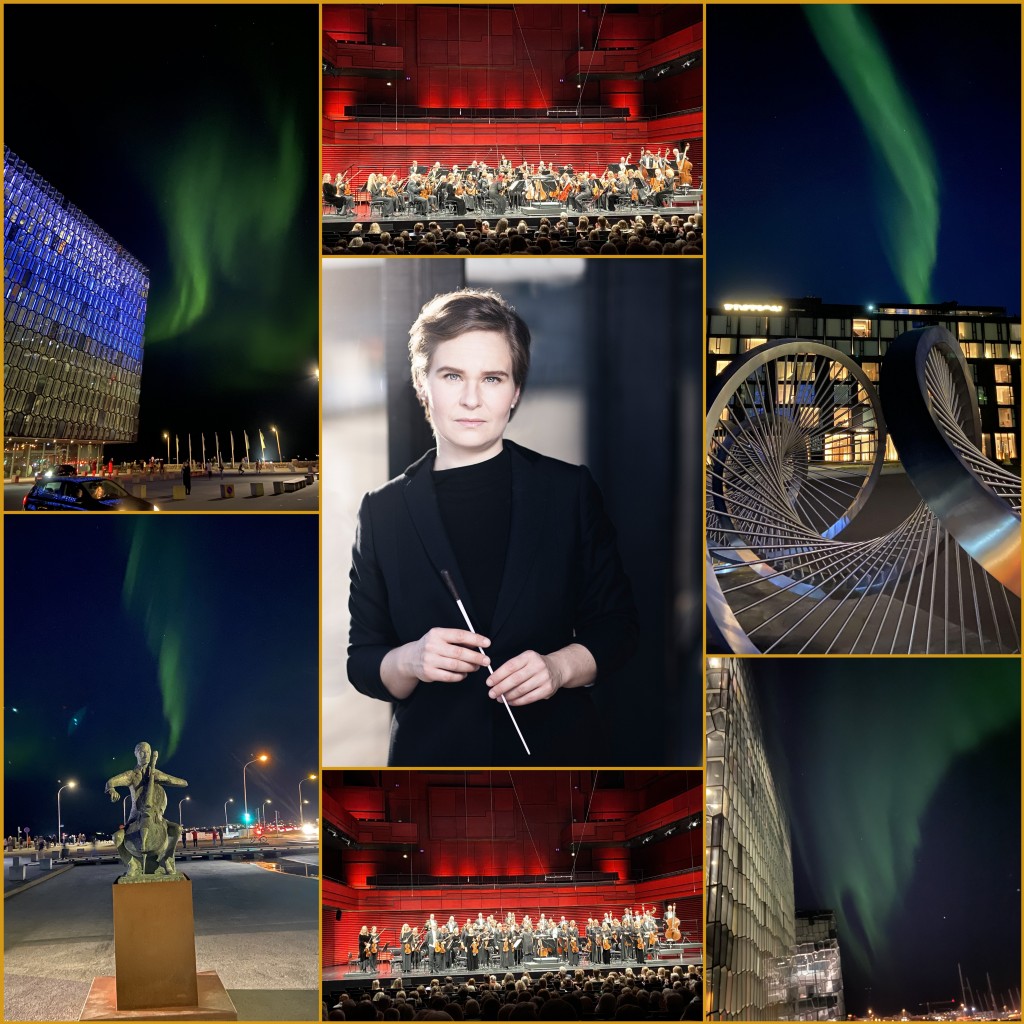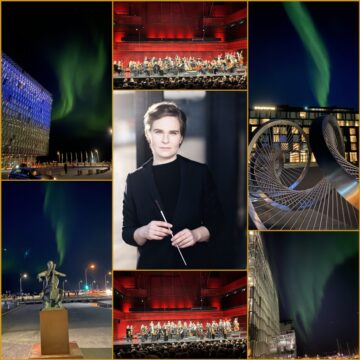It is quite peculiar, even ironic, for a French music lover to have to go to the far reaches of Reykjavik to explore the melodies of his compatriots. However, it is precisely an unusual enchantment that unfolded at the heart of this evening, deserving an exploration beyond the boundaries of music itself. The story of this adventure begins with the wonder inspired by the extraordinary edifice that is Harpa. Nestled near Reykjavik's harbor, this architectural gem stands out with its unique appearance, its facades composed of multicolored hexagonal glass evoking the basalt crystals formed by cooled lava in Iceland. Harpa, born from the collaboration between the architectural firm Henning Larsen and the Icelandic artist Olafur Eliasson, perfectly embodies the union of modernity and art. Upon entering the grand concert hall named Eldborg, the atmosphere envelops guests in a welcoming warmth, the walls adorned with red birch creating an ambiance that prepares for the enchantment to come.
Under the baton of the Finnish conductor Eva Ollikainen, who also serves as the artistic director of the Iceland Symphony Orchestra since 2019, an exceptionally French program of rare elegance was crafted. It began with an enchanting overture, the Prelude to the Afternoon of a Faun by Claude Debussy. The initial notes, soft and enigmatic, immersed the audience in profound reverie. The harps, evoking the grace of a fairy tale, wove a lush sonic tapestry. Then, like a poet of the orchestra, the flute soared, infusing a melody that seemed suspended in time. The conductor's graceful and expansive gestures sculpted a musical poem, captivating souls in a dream both enchanting and gentle, in a vision soft, round, warm, without necessarily retaining the exhilarating and venomous character of the piece.
This exceptional evening was further marked by the prestigious presence of the renowned flutist Emmanuel Pahud, one of the leading figures on the contemporary scene, serving as the principal flute of the Berlin Philharmonic Orchestra. He offered a concertante triptych of rare beauty. The first part was dedicated to Toru Takemitsu's I Hear the Water Dreaming, composed in 1987. Pahud's flute transformed into a masterful storyteller, guiding the audience through soundscapes of unfathomable depth. The musical arabesques, in a language evoking at times Webern and Messiaen, created an almost synesthetic experience. The syncopated, suffocating moments gave way to poetic tension, like a continuous musical stream. The silences, as important as the notes, infused an atmosphere of suspense and contemplation.
Saint-Saëns' Odelette, bewitching with its enchanting Turkish influences, held the audience in thrall. Emmanuel Pahud's masterful flute led us through a high-flying piece, blending virtuosity and pastoral touches, at times reminiscent of Pierné's aesthetics. An accomplice oboe and a virtuosic ensemble created a swirling whirlwind, a musical moment of rare intensity.
In the realm of flute works, Cécile Chaminade's Concertino for Flute, affectionately nicknamed “my little Mozart” by Georges Bizet, shone like a solitary star. Commissioned in 1902 by Théodore Dubois for the flute competition at the Paris Conservatory, this composition pays homage to the flute virtuoso Paul Taffanel. Despite its structure in a single movement, it breaks down into several interconnected sections, each with its own tempo. It rests on two remarkably melodic themes. The first, solemn as a hymn, returns towards the end after a virtuosic cadenza by the soloist. The second, more capricious, frames a central section of dazzling virtuosity. The opening of the Concertino is a genuine invitation to melody, highlighting a decorative solo part. Its main motif seems to have emerged directly from Vincent d'Indy's Symphonie Cévenole, evoking a dreamy, pastoral, singing tonality of delightful, exquisite romanticism. The central section, marked Più animato agitato on the score, offers a whirlwind of emotions, each note laden with passion. A phrase played on the oboe paves the way for a moment of pure virtuosity. The piece concludes in apotheosis, with a reappearance of the opening melody, followed by a breathless coda and impressive trills, where Pahud excels with remarkable ease. His instrumental mastery is unparalleled, and his pianissimos, inherited from the schools of Abbado in Berlin and Lucerne, are breathtakingly beautiful.
The evening reached its zenith with the masterful performance of Johannes Brahms' First Symphony. It was clearly executed as Beethoven's “Tenth Symphony”, a moniker it sometimes receives. The martial and funereal timpani at the beginning set the tone, that of a sort of requiem for the author of the Ode to Joy. Eva Ollikainen, with her always expansive and graceful gestures, conducted this first movement with conviction. She managed to soften, at times, the asperities one might recall from interpretations by Walter, Haitink, or Karajan. The horns distinguished themselves splendidly. The second movement, imbued with nuances in the manner of Mozart, unfolded a sense of autumnal grace often associated with Brahms. A magnificent first violin, with a deeply moving vibrato, took the lead. The third movement, played with more drama and passion, at times evoked Beethoven. The high quality of the brass and the overall dynamism of the orchestra marked this interpretation. The conductor infused grandeur and even solemnity into the final movement, reminiscent of Dvorák in its timbre and Beethoven in its melodic line, almost resembling the finale of the Ninth Symphony. In measured tempos, the orchestra unfolded and breathed, under the smiling and graceful baton of Eva Ollikainen, especially in the majestic and triumphant coda.
Leaving this exceptionally beautiful concert, the magic continued with a surprising northern lights display that illuminated the sky above Harpa, creating a silent spectacle, a true concerto of celestial organs. This is another facet of the music of the spheres, for those who deign to pay attention to this phenomenon as wonderful as it is fascinating.
Philippe Rosset
September 14th



